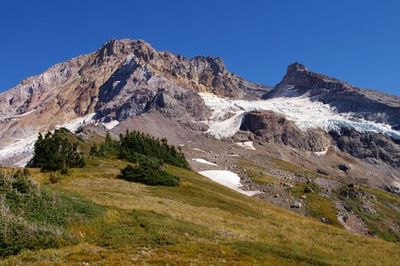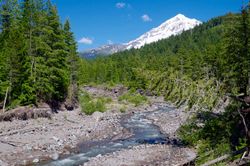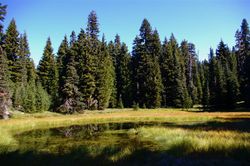Yocum Ridge Hike
From Oregon Hikers Field Guide
- Start point: Ramona Falls Trailhead
- End point: Yocum Ridge
- Trail Log: Yocum Ridge Hike/Log
- Distance: 18.4 miles
- Elevation gain: 3880 feet
- High point: 6,825 feet
- Difficulty: Difficult
- Seasons: July through October
- Family Friendly: No
- Backpackable: Yes
- Crowded: as far as Ramona Falls
Contents |
Hike Description
What's nice about Yocum Ridge is that it's so remote. There aren't any other alpine areas on Mount Hood as far away from a trailhead. The early sections of this hike are among the busiest around the mountain, but after four miles, you'll start on the Yocum Ridge Trail, and you'll enjoy some of the best solitude the region can offer! Start the hike early, and you can get Ramona Falls to yourself. Also, the early brisk air helps you up those switchbacks to Yocum Ridge. Here you'll enjoy an alpine panorama unmatched on the mountain. A couple of benches off the north side of the ridge offer campsites.
Take the wide, sandy trail leading up from the southeast corner of the parking area. You will be hiking among stunted mountain hemlock, Douglas-fir, and lodgepole pine on a carpet of moss, pinemat manzanita, and reindeer lichen. Beginning in about 1780, pyroclastic flows from Mount Hood buried the Sandy River, which continues to change its course as it carves through the soft strata. Pass the first of at least three glacial river crossing signs warning about safe passage when waters are high. (There has been more than one drowning death in the area.) Come to the Sandy River-Ramona Falls Trailhead Trail Junction, and proceed past a large boulder to a stop sign, where you’ll need to fill out a free wilderness permit.
Hike onward through the trees. The trail has been moved back away from the river after sections that were too close to the riverbank washed away. At 1.1 miles reach the bank of the river, and then descend to the Sandy River Crossing. A bridge is no longer provided here, so you’ll need to pick one of the logs strewn across the water or attempt a ford (see Tips for Crossing Streams). This crossing can be dangerous and is easiest from mid-summer to early fall. The trail picks up on the opposite bank and winds through an alder-colonized debris fan. Drop in and out of a gully, and head up parallel to the river in shady woods. Come to the Pacific Crest-Sandy River Trail Junction, and go left. The trail soon reaches a footbridge over Ramona Creek and heads up the bank of the creek. At the well-signed Ramona Falls-Pacific Crest Trail Junction, keep right.
Pass through a stile (no horses are permitted on the Ramona Falls Trail) and head up through the shady woodland that has revegetated the pyroclastic flows. Cross a log footbridge, and hike up along lovely, burbling Ramona Creek, which flows through the duff carpet and mossy stones. Look left to note the wonderful pink and sandy andesite cliffs across the creek. Leave the stream to pass above a gully, and keep rising through mountain hemlock, western hemlock, Douglas-fir, western red-cedar, lodgepole pine, rhododendron, and Sitka alder. Reach the junction with the Timberline Trail, and stay right to admire Ramona Falls' splashing veil from the footbridge that spans the creek here. There are plenty of places to sit and contemplate a while under the shady canopy although, on a summer weekend, there may be throngs that have the same idea.
Then return to the Timberline Trail, and begin an ascending traverse in a shady old-growth forest of cedar, Douglas-fir, and western hemlock. Numerous seeps and springs drip from the mossy, maidenhair fir-draped andesite rock faces. Cross a footbridge over a boggy spring. Mature noble firs and silver firs enter the mix in lush woods with deer fern, huckleberry, devil’s club, and bunchberry forming the understory. At the nose of the ridge, the Yocum Ridge Trail #771 heads up to the right, four miles from the trailhead.
The trail heads up the south side of the ridge. At this end, there are a number of wind-snapped snags and large rock outcroppings in the forest above. Then the trail rises again and crosses a talus slope rimmed with Sitka alder and vine maple. Massive noble firs stand sentinel at this clearing’s edges. At 5.0 miles, watch for a faint trail heading right. You'll discover a great viewpoint overlooking Mount Hood, the Sandy River, and the Zigzag Ridge. There is a small flat area here, just big enough for a tent. Switchback to pass more large noble firs in an understory of bear-grass and silver fir saplings. Reach the rim of the Muddy Fork’s canyon and hike upward. Mountain hemlocks become more common. The trail drops slightly along the south side of the ridge and switchbacks in a sunny bear-grass and huckleberry clearing above a talus slope squeaking with pikas. At the ridgecrest again, the trail passes a small pond in a meadow. A spur left leads to the sphagnum shores. Keep heading up in mountain hemlock and silver fir stands with a bear-grass carpet. Lovely glades with bloomed-out avalanche lilies, lupine, groundsel, and false hellebore appear. At 6.7 miles, a spur right leads to a small stream in a willow thicket. This is your last reliable year-round water source.
The main trail swings left across the ridge above a wet meadow potholed with small ponds. You're now on the north side of the ridge above the Muddy Fork, and views of the Washington volcanoes (Mount Saint Helens, Mount Rainier, Mount Adams) open up across the wide valley of the West Fork Hood River. The trail keeps rising and switchbacks to the edge of the Muddy Fork Canyon with more views of the Washington mountains, as well as Lost Lake and Mount Defiance. Then cross a talus slope giving views across Zigzag Mountain. Subalpine fir now in the mix tells you that the trail is nearing the timberline. A traverse of several meadows offers great views across the Sandy River Canyon to Paradise Park. Mount Jefferson also becomes visible far to the south. The trail heads above a talus slope and across a meadow blooming with asters. Pass above a spring which runs dry in the summer and then, at 8.0 miles and 6,000 feet, head up a wide meadow to go right on a spur to a spectacular viewpoint. This looks across the Sandy Canyon’s void to waterfalls gushing down from the Reid Glacier; also in view are Illumination Rock, Yocum Ridge, Paradise Park, and Zigzag Mountain. Looking west on a clear day, a good eye can see as far out as Portland and the mountains of the coast range, including Elk Mountain and Saddle Mountain.
Back on the main trail, go right. The trail then switchbacks to the left and begins a gradual ascent to traverse up lush meadows still blooming with asters. The route drops below a rock outcropping, traverses through mountain hemlock copses, crosses another meadow, and comes to a viewpoint over the Muddy Fork’s canyon and across to McNeil Point. Now the trail heads up the north side of Yocum Ridge above lush benches. Pass a campsite on the right. (There are a couple of others below on the benches, and there may be running water coming out of the snowfields.) The tread reaches a steep rubbly slope and effectively peters out. Cross the unstable rubble, heading upward under a snowfield. Then reach the ridgecrest and keep ascending, passing mountain hemlock, white bark pine, and subalpine fir krummholtz. Maple-leaf currant, common juniper, and Sitka mountain ash are the main alpine shrubs here. Yocum Ridge levels at a grassy meadow. Paintbrush, cinquefoil, and lupine bloom down by a snowfield. There are expansive views from Mount Rainier to the Three Sisters and Broken Top. You can see to a wide bench below the present terminus of the Sandy Glacier.
Maps
- Maps: Hike Finder
- Green Trails Maps: Government Camp, OR #461 and Mt Hood, OR #462
- Adventure Maps: Mt. Hood Area
- U.S. Department of Agriculture, Forest Service: Zigzag Ranger District
- Discover Your Northwest: Mt. Hood National Forest North: Trail Map & Hiking Guide
- U.S. Department of Agriculture, Forest Service: Mt. Hood National Forest
- National Geographic Trails Illustrated Map: Mount Hood
- National Geographic Trails Illustrated Map: Mount Hood Wilderness
Fees, Regulations, etc.
- Northwest Forest Pass (or America the Beautiful Pass) required at trailhead. Pass must be acquired beforehand as they are not sold at the trailhead.
- Free self-issued wilderness permit
- Wilderness rules apply
Trip Reports
- Search Trip Reports for Yocum Ridge
Related Discussions / Q&A
- Search Trail Q&A for Yocum Ridge
Guidebooks that cover this hike
- PDX Hiking 365 by Matt Reeder
- Off the Beaten Trail by Matt Reeder
- Day Hikes in the Pacific Northwest by Don J. Scarmuzzi
- 100 Hikes in Northwest Oregon & Southwest Washington by William L. Sullivan
- Afoot & Afield: Portland/Vancouver by Douglas Lorain
- 100 Classic Hikes in Oregon by Douglas Lorain
- Hiking Oregon's Mount Hood & Badger Creek Wilderness by Fred Barstad
- 105 Virtual Hikes of the Mt. Hood National Forest by Northwest Hiker
- Oregon Hiking by Sean Patrick Hill
- Hiking Oregon by Donna Lynn Ikenberry
- 100 Oregon Hiking Trails by Don & Roberta Lowe
- 70 Hiking Trails: Northern Oregon Cascades by Don & Roberta Lowe
- 62 Hiking Trails: Northern Oregon Cascades by Don & Roberta Lowe
More Links
- Sandy River Trail #770 (USFS)
- Ramona Falls Trail #797 (USFS)
- Timberline National Historic Trail #600 (USFS)
- Yocum Ridge Trail #771 (USFS)
- Yocum Ridge Hike (Northwest Hiker)
- Yocum Ridge: Up Past Ramona Falls Lies A Great Mount Hood Hike (Author Paul Gerald)
- Mt Hood: Yocum Ridge (Dean Myerson)
- Hike 26 - Yocum Ridge (Goal Tech)
- Yocum Ridge via Ramona Falls (Evergreen Hiker)
- Yocum Ridge (Roaming Log)
- Yocum Ridge, OR (EyeHike)
- Yocum ridge hike (jessB)
- Yocum Ridge (Outdoor Project)
- Yocum Ridge Trail (All Trails)
Contributors
- User:retiredjerry (creator)









